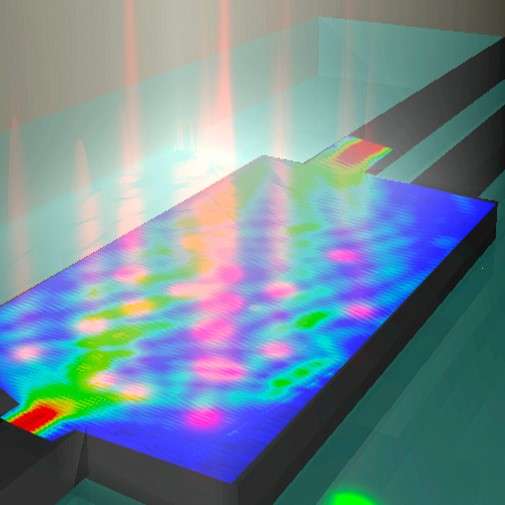Controlling integrated optical circuits using patterns of light

Researchers from the University of Southampton (UK), and the Institut d'Optique in Bordeaux (France) have devised a new approach for controlling light in a silicon chip by bringing the concept of spatial light modulation to integrated optics.
Silicon photonics are forming the backbone of next-generation on-chip technologies and optical telecommunication, which are aimed at a wide range of emerging applications including optical interconnects, microwave photonic circuits, and integrated optical sensors.
Photonic chip functionality is usually hard-wired by design, however reconfigurable optical elements would allow light to be routed flexibly, opening up new applications in programmable photonic circuits.
Traditional spatial light modulators are based on liquid crystals or micro mirrors and provide many independently controllable pixels. This technology has revolutionised optics in recent years, with many applications in imaging and holography, adaptive optics and wavefront shaping of light through opaque media.
In their new work, presented in the April issue of the journal Optica, the team makes use of multimode interference (MMI) devices, which form a versatile class of integrated optical elements routinely used for splitting and recombining different signals on a chip. The geometry of the MMI predefines its characteristics at the fabrication stage.
The team shows that the intricate interplay between many modes travelling through the MMI can be dynamically controlled. A pattern of local perturbations, induced by femtosecond laser, acts in concert to effectively shape the transmitted light. Related to wavefront shaping in free-space optics, this allows to freely route light in a static silicon element, thus transforming the device into a much needed building block for field-programmable photonics.
Lead author Roman Bruck, a postdoctoral researcher at the University of Southampton, says: "We have demonstrated a very general approach to beam shaping on a chip that provides a wide range of useful functionalities to integrated circuits. The integrated spatial light modulator turns conventional silicon photonics components into versatile reconfigurable elements."
Practical applications of this technology will include all-optical reconfigurable routers, ultrafast optical modulators and switches for optical networks and microwave photonic circuits as well as wafer-scale optical testing of photonic chips. More work is needed to develop these ideas into practical applications.
Principal investigator Professor Otto Muskens, from Physics and Astronomy at the University of Southampton, says: "There are many new directions to explore, from gaining a deeper understanding to application of the new concepts into real-world devices. This is a potentially disruptive new approach toward field-programmable chips which can enhance and complement existing strategies, or even partially replace current technology."
More information: Roman Bruck et al. All-optical spatial light modulator for reconfigurable silicon photonic circuits, Optica (2016). DOI: 10.1364/OPTICA.3.000396
Journal information: Optica
Provided by University of Southampton



















